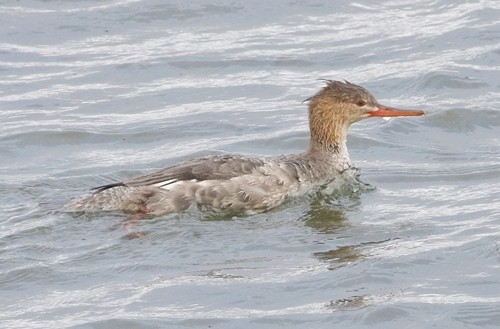Red-breasted Merganser
A species of Typical mergansers Scientific name : Mergus serrator Genus : Typical mergansers
Red-breasted Merganser, A species of Typical mergansers
Botanical name: Mergus serrator
Genus: Typical mergansers
Content
Description People often ask General Info
 Photo By silversea_starsong , used under CC-BY-NC-4.0 /Cropped and compressed from original
Photo By silversea_starsong , used under CC-BY-NC-4.0 /Cropped and compressed from original Description
The adult red-breasted merganser is 51–62 cm (20–24 in) long with a 70–86 cm (28–34 in) wingspan. The red-breasted merganser weight ranges from 28.2 to 47.6 oz (800-1350 g). It has a spiky crest and long thin red bill with serrated edges. The male has a dark head with a green sheen, a white neck with a rusty breast, a black back, and white underparts. Adult females have a rusty head and a greyish body. The juvenile is like the female, but lacks the white collar and has a smaller white wing patch. 
Size
41 - 66 cm
Colors
Brown
Black
Gray
White
Life Expectancy
9 years
Nest Placement
Ground
Clutch Size
3 - 24 eggs
Incubation Period
1 brood
Number of Broods
28 - 35 days
Feeding Habits
Red-breasted Merganser primarily consume small fish, supplementing their diet with crustaceans, insects, and tadpoles. They forage in shallow waters with diverse vegetation in summer and shallow marine waters in winter. Red-breasted Merganser employ diving or 'snorkeling' techniques and sometimes herd prey. Their serrated bills assist in gripping slippery fish.
Habitat
Red-breasted Merganser can typically be found in diverse aqueous environments, from boreal forest wetlands to coastal regions. They favor fresh, brackish, and saltwater habitats, often in proximity to the coast. Altitude variances are tolerated, provided the availability of open water. These birds prefer areas with ample access to both nesting sites and aquatic food sources. During migration, they utilize lakes, rivers, and particularly oceanic waters, including estuaries and coastal bays, with a noted preference for saltwater habitats over their Common Merganser counterparts.
Nest Behavior
Red-breasted Merganser's female selects the nest site and builds the nest. Egg-laying occurs in the spring, and she solely incubates the eggs with occasional male presence. Both parents may assist in feeding the young post-hatching.
Nest Characteristics
Red-breasted Merganser's nest is often on ground near water, concealed under dense cover like low branches, logs, or boulders. It's a shallow bowl lined with dead grass and insulating down feathers from the female's breast.
Dite type
Piscivorous
People often ask
General Info
Feeding Habits
Bird food type
Sounds
Call
Recording location: United States
Behavior
Red-breasted Merganser are remarkable for their aerial speed, reaching up to 81 miles per hour. Required to gain momentum on water for takeoff due to their rear-set legs, they adeptly move from water to air. On land, their locomotion is awkward but transforms into agile diving in aquatic surroundings. This species is sociable throughout the year, not defending territories. Unique courtship displays include males' high-head salutes and curtsying to females, who may respond with a bill jab. Males also perform a side-to-side head shake. Accepted males witness females stretch their necks and bob in a ritualistic motion. Seasonal monogamous bonds form, but males abandon females post-mating, leaving them to raise offspring solo and retiring to molt in preparation for migration. Conversely, females generally molt in proximity to breeding grounds.
Species Status
The red-breasted merganser is one of the species to which the Agreement on the Conservation of African-Eurasian Migratory Waterbirds (AEWA) applies. 
Scientific Classification
Phylum
Chordates Class
Birds Order
Waterfowl Family
Geese Genus
Typical mergansers Species
Red-breasted Merganser